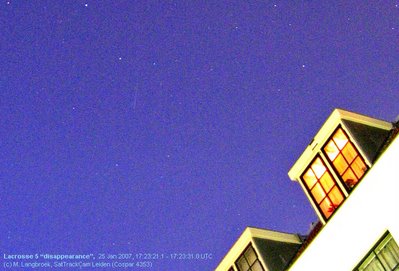I was awake very early in the morning yesterday (Jan 25th) after managing only a few hours of sleep. At 5:30 am local time I decided to make something good out of something bad, by checking whether there were any satellite passes to observe. It turned out Lacrosse 3 (97-064A, #25017) made a nice zenith pass, emerging out of eclipse just south of the Big Dipper. So I observed and imaged it.
It was a very dark and transparent, cold night (-0.7 C, the first night with true frost at Cospar 4353 this winter, ridiculously late). Lacrosse 3 was bright, magnitude +2, and I obtained 2 images (hence 4 positions).
As an unanticipated extra, there was a faint second trail on the first image. It was clearly shorter than the Lacrosse trail, so at first I was in some doubt whether it was a satellite at all and not for example a meteor.
I could subsequently positively ID it however as Kosmos 624 (73-104H, # 06992) an old 1973 Soviet Strela-1M communications satellite. Amazing as it "should" have been mag. +7 only (instead it was something like mag. +4, judging from the trail. I did not see it visually)!
The reason the trail was so short, is that its orbit is higher than that of my usual targets: it was at over 1500 km altitude at the time of observation. It must also be the smallest object I imaged so far, as its RCS is only 0.8 m^2.
In the evening I made a second observing run, imaging Lacrosse 5 (05-016A) and Lacrosse 4 (00-047A). Like the previous nights, Lacrosse 5 performed its "disappearance trick" again, this time at 17:23:23 UTC. Before that time is already was somewhat variable, alternating between mag. +1 and +2.5. The observation was done in a blue twilight sky. Upcoming cirrus and a nearby moon prevented me from observing a later second pass of the satellite.
(click images to enlarge)
















